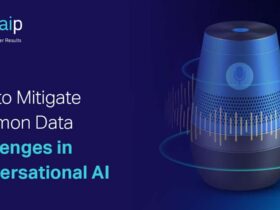Learn about the concept of Natural Language Processing (NLP). Aicorr.com analyses and provides an overview of NLP and its characteristics within artificial intelligence (AI).
Table of Contents:
- Natural Language Processing
Natural Language Processing
Natural Language Processing (NLP) is a rapidly advancing field within artificial intelligence (AI) that focuses on the interaction between computers and human languages. It encompasses a range of techniques and algorithms that enable machines to understand, interpret, and generate human language in ways that are both meaningful and useful. As one of the most dynamic areas in technology today, NLP has transformed industries such as healthcare, customer service, marketing, and even creative fields like content generation.
NLP Overview
At its core, NLP is concerned with the challenge of enabling machines to process and analyse large amounts of natural language data. Unlike structured data, which is neatly organised in databases, natural language is inherently unstructured and ambiguous. Human communication involves idioms, metaphors, slang, and varying sentence structures, all of which make language difficult for computers to interpret.
To address this complexity, NLP relies on a combination of computational linguistics and machine learning techniques. Computational linguistics involves rule-based approaches that leverage grammar rules and language structure, while machine learning enables models to learn from large datasets and recognise patterns within language. The synergy of these techniques forms the foundation for many of the NLP applications we see today.
Key Components of NLP
There are several essential tasks within NLP that contribute to a machine’s ability to process language. Let’s briefly explain each one of them below.
1. Tokenisation involves breaking down a text into smaller units, such as words or sentences. Tokenisation helps in analysing text by simplifying it into manageable pieces.
2. Part-of-Speech Tagging (POS) task involves identifying the grammatical roles of words within a sentence, such as whether a word is a noun, verb, or adjective.
3. Named Entity Recognition (NER) focuses on identifying and categorising proper names within text, such as people, locations, dates, and organisations.
4. Sentiment Analysis is the process of determining the emotional tone behind a piece of text. It is widely used in marketing and customer service to gauge public perception of products or services.
5. Parsing involves analysing the grammatical structure of sentences to determine relationships between words. This helps in understanding complex sentence structures.
6. Text Classification task involves categorising text into predefined groups, such as spam detection in emails or topic identification in articles.
7. Machine Translation is one of the most well-known applications of NLP. Machine translation involves translating text from one language to another. Google Translate is a prime example.
8. Text Generation involves creating human-like text based on a given input. This capability is used in chatbots, virtual assistants, and content generation tools.
Machine Learning and Deep Learning in NLP
In recent years, advancements in machine learning, particularly deep learning, have significantly enhanced the capabilities of NLP systems. Traditional rule-based systems required extensive manual effort to create rules and dictionaries, but machine learning models can learn directly from data. This shift has enabled the development of more accurate and scalable NLP solutions.
Deep learning models, such as recurrent neural networks (RNNs) and transformers, have been particularly transformative. Transformers, in particular, have revolutionised NLP with architectures like BERT (Bidirectional Encoder Representations from Transformers) and GPT (Generative Pre-trained Transformer). These models can handle large-scale text data, capture contextual relationships between words, and generate high-quality text outputs.
Applications of NLP
NLP has become an integral part of numerous applications that impact our daily lives. We explore some of the most common applications of natural language processing.
- 1. Virtual Assistants: Siri, Alexa, and Google Assistant rely on NLP to understand voice commands and provide appropriate responses.
- 2. Chatbots: Many businesses use NLP-powered chatbots to handle customer inquiries, provide support, and improve user engagement.
- 3. Sentiment Analysis: Companies monitor social media and customer reviews using sentiment analysis tools to assess public sentiment and make informed business decisions.
- 4. Healthcare: NLP helps in analysing medical records, extracting valuable information, and even assisting in diagnostic processes.
- 5. Content Moderation: Social media platforms use NLP to identify and remove inappropriate content automatically.
- 6. Document Summarisation: NLP models can generate concise summaries of lengthy documents, making information more accessible.
- 7. Language Translation: Tools like Google Translate rely on NLP to provide accurate translations between multiple languages.
- 8. Voice Recognition: Speech-to-text applications use NLP to convert spoken language into written text.
- 9. Personalised Recommendations: Platforms like Netflix and Spotify use NLP to analyse user preferences and deliver tailored content recommendations.
Challenges in NLP
Despite its remarkable progress, NLP still faces several challenges: Ambiguity, Context Understanding, Multilingual Support, Ethical Concerns, and Data Privacy.
First, ambiguity. Language ambiguity, where words or phrases have multiple meanings, remains a significant hurdle for NLP models. Secondly, context understanding. Understanding context and maintaining coherence across long conversations is a challenge for many NLP systems. Furthermore, NLP faces multilingual support. Meaning, developing NLP models that work seamlessly across different languages and dialects is complex. There are also ethical concerns to be considered. NLP applications can perpetuate biases present in training data, leading to unfair outcomes in applications like hiring or content moderation. And finally, data privacy. The use of large amounts of text data raises concerns about data privacy and security.
The Future of NLP
As the field of NLP continues to evolve, several exciting trends are shaping its future.
1. Multimodal Learning – combining text with other data types, such as images and audio, is expected to enhance the capabilities of NLP systems.
2. Explainability – developing models that can explain their decision-making processes will be crucial for gaining user trust and addressing ethical concerns.
3. Real-Time Translation: Advances in NLP will likely lead to more seamless and real-time language translation tools.
4. Ethical AI – researchers and developers are placing increased emphasis on creating ethical NLP systems that minimise bias and protect user privacy.
5. Domain-Specific NLP – as NLP becomes more sophisticated, tailored solutions for specific industries, such as law and finance, will become more prevalent.
The Bottom Line
NLP is a transformative technology that bridges the gap between human communication and machine understanding. Its applications are vast and impactful, touching nearly every industry and aspect of our lives. As advancements in machine learning and AI continue, NLP will play an increasingly central role in shaping the future of technology and communication.












